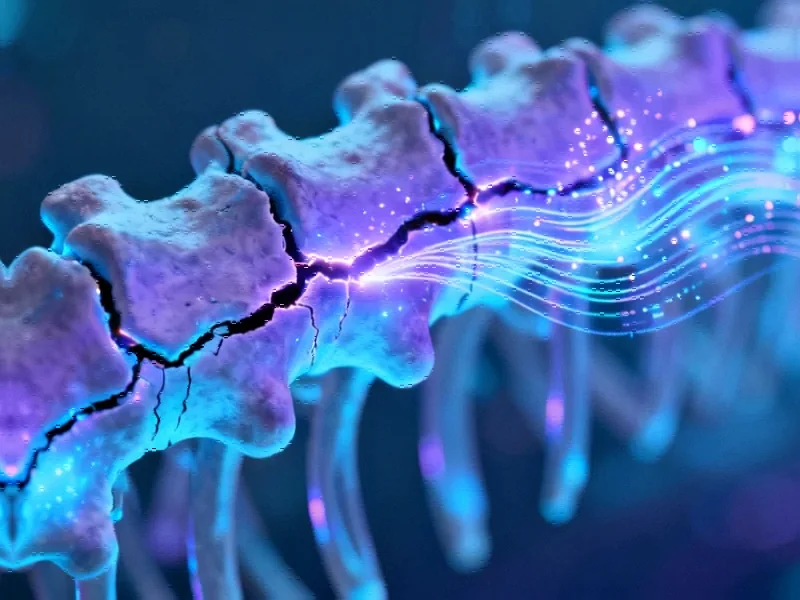Revolutionizing Osteoporosis Detection with Machine Learning
In a significant advancement for preventive healthcare, researchers have developed a machine learning tool that can predict newly diagnosed osteoporosis using only primary care data. This innovative approach leverages artificial intelligence to identify at-risk patients before fractures occur, potentially transforming how healthcare systems address this silent but devastating condition.
The research, conducted in the Stockholm Region, utilized Stochastic Gradient Boosting (SGB) machine learning methodology to analyze diagnostic patterns from primary care visits. By examining data from over 30,000 patients aged 40 and above, the model achieved remarkable accuracy with area under the curve (AUC) scores exceeding 0.899 across all age and sex strata.
Key Predictive Factors Revealed
Perhaps the most surprising finding was that the number of primary care consultations in the year preceding diagnosis provided the strongest predictive information across all demographic groups. This suggests that healthcare-seeking behavior itself may be an important indicator of underlying bone health issues.
Additionally, the study identified several diagnostic patterns with high predictive value. Unspecific conditions such as dorsalgia (back pain) and other musculoskeletal disorders showed significant normalized relative influence (NRI) scores ranging from 2.6% to 9.0%. Interestingly, hypertension emerged as a strong predictor specifically for patients over 65 years, though not for younger cohorts.
These findings align with recent AI model developments that demonstrate how machine learning can extract meaningful patterns from routine healthcare data.
The Growing Challenge of Osteoporosis
Osteoporosis represents an increasing burden on healthcare systems worldwide, particularly as populations age. Characterized by reduced bone density and deterioration of bone tissue microarchitecture, the condition significantly increases fracture risk from minimal trauma. Vertebral fractures, often undiagnosed, profoundly impact mobility and quality of life, while hip fractures typically require hospitalization and surgical intervention.
The World Health Organization has recognized the urgency of this issue, calling for primary care to take leadership in screening and managing osteoporosis. Current diagnostic methods primarily rely on dual-energy X-ray absorptiometry (DXA) to measure bone mineral density, but accessibility and systematic application remain challenges.
Advantages Over Traditional Assessment Tools
While established tools like FRAX® (Fracture Risk Assessment Tool) provide valuable risk assessment, the machine learning approach offers several distinct advantages. By automatically analyzing routinely collected clinical information, AI systems can identify complex patterns that might escape conventional assessment methods.
This research represents a shift from traditional risk factor analysis toward pattern recognition in healthcare data. Similar computational approaches in material science demonstrate how AI can reveal hidden relationships in complex systems.
Integration with Broader Healthcare Innovation
The success of this osteoporosis prediction model reflects broader trends in healthcare technology. Across the medical field, researchers are developing sophisticated AI tools to improve diagnosis and treatment planning. For instance, pharmacogenomics models are transforming how medications are personalized to individual genetic profiles.
Similarly, advancements in medical device technology are creating new possibilities for patient monitoring and treatment. These parallel developments across healthcare technology sectors highlight the transformative potential of computational approaches in medicine.
Implementation Challenges and Opportunities
Implementing such predictive models in routine primary care presents both challenges and opportunities. Healthcare systems must ensure data privacy, address potential biases in training data, and integrate AI tools seamlessly into clinical workflows. However, the potential benefits are substantial – earlier intervention, reduced fracture incidence, and decreased healthcare costs.
The research team emphasized that their approach differs from previous machine learning models by focusing specifically on primary care diagnoses and healthcare-seeking behaviors. This methodology could be adapted for other conditions where early warning signs manifest in primary care settings.
Future Directions and Broader Implications
Looking forward, the integration of genetic information could further enhance prediction accuracy. While current understanding suggests heredity explains about 75% of bone density variability, specific genetic markers account for only approximately 20%. Combining genetic data with the diagnostic patterns identified in this study could create even more powerful prediction tools.
This research contributes to the growing field of genomic medicine, where comprehensive biological data informs clinical decision-making. Additionally, the analytical methods developed could inspire innovations in other data-rich fields where pattern recognition drives discovery.
Transforming Preventive Healthcare
The development of this osteoporosis prediction model represents a significant step toward proactive, preventive healthcare. By identifying at-risk individuals before fractures occur, healthcare providers can implement preventive measures including lifestyle modifications, nutritional supplements, and when appropriate, pharmacological interventions.
As healthcare systems worldwide grapple with aging populations and rising chronic disease burdens, such AI-driven approaches offer promising solutions. The successful application of machine learning to osteoporosis prediction demonstrates how routine clinical data, when properly analyzed, can yield insights that transform patient care and outcomes.
This research underscores the potential for artificial intelligence to address longstanding challenges in healthcare delivery, particularly for conditions like osteoporosis that often remain undiagnosed until serious complications occur. As these technologies mature and integrate into clinical practice, they promise to make preventive, personalized medicine increasingly accessible to populations worldwide.
This article aggregates information from publicly available sources. All trademarks and copyrights belong to their respective owners.
Note: Featured image is for illustrative purposes only and does not represent any specific product, service, or entity mentioned in this article.



